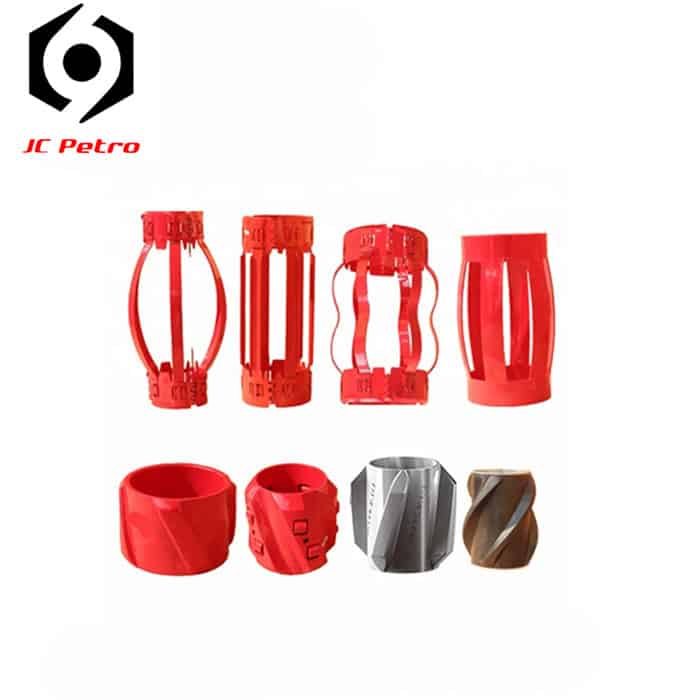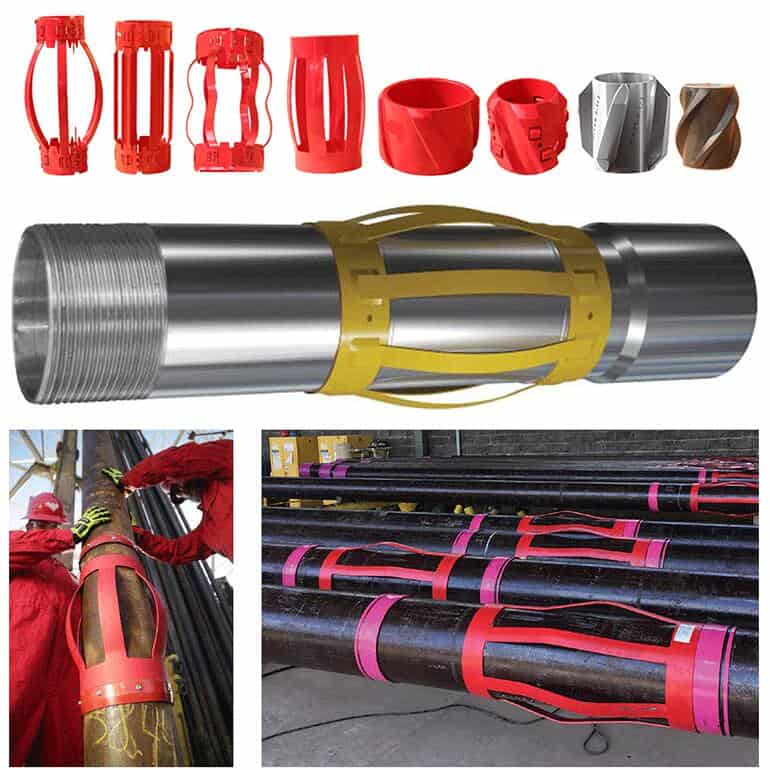Casing Centralizers
Type: Bow Spring, Rigid, Semi-Rigid, Roller, Composite
Size: From 4 1/2“ to 20″
WhatsApp: +86 158 0546 5460
Description
Casing centralizer meaning is a mechanical device or cementing tool. It is an integral part of the cementing process.
It is installed outside the casing string secured around the casing at various locations to keep the casing from contacting the well bore walls, acts as a righting sleeve in the well bore.
They provide the mechanism that centers the casing in the hole and allows uniform cement flow around the casing to help protect it at all points.
Casing centralizer as a cementing tool is applied in vertical, deviated and horizontal wells to centralize casing for improving the cementing quality.
As a result of casing centralization, a continuous annular clearance around the casing allows cement to completely seal the casing to the borehole wall.
The cement could be concreted firmed between casing and borehole wall.It can be installed on casing joint or any position working with stop collar for centralizing.
All models offer ample clearance for fluid passage and are extra effective in centering the casing, even in highly deviated holes and improve cement flow by reducing the effects of channeling.
Several styles of centralizers are available for matching different well specifications and hole sizes, including turbulence generating designs that help clean the annuls and distribute the cement more evenly and uniformly.
Casing Centralizers Types
There are various types of Casing Centralizers used in the oil and gas industry, but these are the 2 primary types of centralizers:bow spring centralizers and rigid centralizers.
(If As per action form, it can be divided into Bow Spring casing centralizer, rigid casing centralizer and semi-rigid centralizer.)
Bow-Spring Centralizer
This type of centralizer is a bow-shaped metal strip used to centralize the casing in a borehole so as to improve the efficiency of cementing.
Bow spring centralizers are slightly larger in diameter than the well bore, so they become slightly compressed when inserted into the well bore. They are often used in vertical wells as there is near zero deviance in annular space about the tool.
(As per structure of the righting strip,the elastic centralizer can be divided into single bow centralizer and a double bow centralizer.)
Rigid Centralizer
This type of centralizer is built using steel or cast iron and works well with the deviated wellbores. It is not as effective as bow-spring centralizers.
Rigid centralizers are slightly smaller than the well bore.
They are more commonly used in deviated or horizontal well bores where the weight of the casing string would cause a bow spring centralizer to experience eccentric compression which could jeopardize the seal.
(The rigid casing centralizer can be divided into ordinary rigid centralizer and roller rigid centralizer.)
Specification
JC Petro casing centralizer has the characteristics of simple structure, convenient use, long service life and low relative cost.
- a. Designed for high restoring force and low starting & running force.
- b. End collars are designed with self-locking action, which are easy to assemble.
- c. Undergo special coating process to prevent from rust.
- d. Can be shipped in half assembled condition for economy in shipping and storage costs.
- e. Specification: 4 1/2”-20”. Any special sizes or combination can available on request.
- f. Super-strength spring steel
- g. Model processing, no rivet, no welding
- h. 3-section structure for easy transport
- i. Easy installation
Centralizers position the casing or tool string in the center of the tubing, casing, or wellbore. They may be used for cementing operations or for tool placement.
Casing centralizer is one of the necessary conventional casing accessories, upon well operations completion, the rational use of casing centralizer can play the role of:
Reducing lower casing resistance phenomenon.
Making the casing smoothly down to the design position.
Making casing centralizer centered within the well.
Reducing the sticking phenomenon to make the annular space hydrostatic pressure balanced.
Reduce channeling, improve the mud replacement efficiency, thus improve the cementing quality.
Strengthen the casing, keep the casing centered, and ensure that the annuls cement ring is evenly distributed.
Prevent the casing from sticking in the high permeability formation, ensuring the smooth entry of the casing.
Reduce casing penetration and resistance, reduce casing wear, scrape off loose mud cakes, and improve cement and formation quality.

